简单句并列句复合句
- 格式:doc
- 大小:28.50 KB
- 文档页数:1

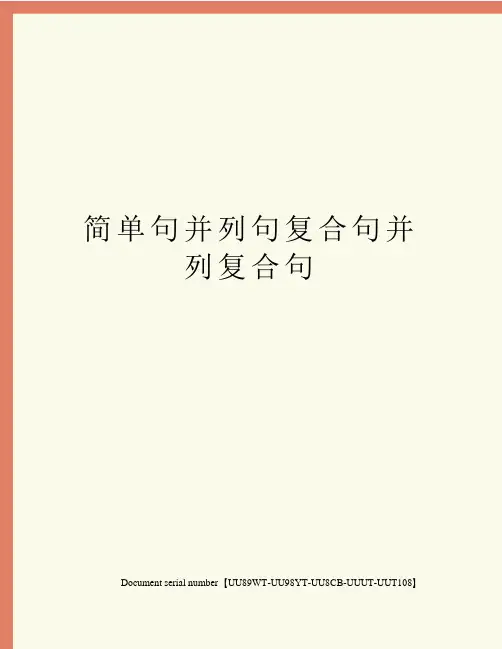
简单句并列句复合句并列复合句Document serial number【UU89WT-UU98YT-UU8CB-UUUT-UUT108】简单句、并列句、复合句、并列复合句文章来源:在前面各讲中所说的肯定句、否定句、各种疑问句、感叹句等,是根据句子的作用来划分的。
今天,我们再学习一种新的分类方法:即根据句子的内部结构,特别是句子与句子之间的关系来划分的方法。
根据句子结构,可以分为三种主要类型:简单句、并列句、复合句,另外还有一种叫并列-复合句子。
要搞懂英语句子结构分类,有一点首先必须明白:即什么是“句子”句子的概念有两层含义:一是它能表达一个清晰、完整的意思。
反过来讲,只要能表达一个清晰、完整的意思的语言单位,不论是长是短,哪怕是一个单词,也算作是一个句子。
这是从意义方面来说的。
二是句子的结构完整。
所谓“完整”,最核心的是一个句子应该有“主语、谓语”。
也就是说,有主语、有谓语的语言单位就是一个句子。
这就是从句子结构方面来分的,也是从句子语法成份方面来划分的。
我们所讲的简单句、并列句、复合句都是从主语、谓语来判定句子类型的。
如果按照句子的结构分类,英文句子可分为三种类型:简单句(Simple Sentence),并列句(Compound Sentence)和复合句(Complex Sentence)。
一、简单句简单句的定义是:或者只有一个主语,或者只有一个谓语。
为什么说“或者”呢因为简单句可以只有一个主语,但有几个谓语;或者可以有几个主语,但只有一个谓语。
这样一分,简单句就有三种形式了。
1、只有一个主语、一个谓语,再加上其它成份。
例如:Light travels faster than sound.光比声传播速度快。
The film is not interesting.这部电影没有意思。
Can you finish the work on time你能按时完成工作吗2、只有一个主语,但有几个谓语,再加上其它成份。
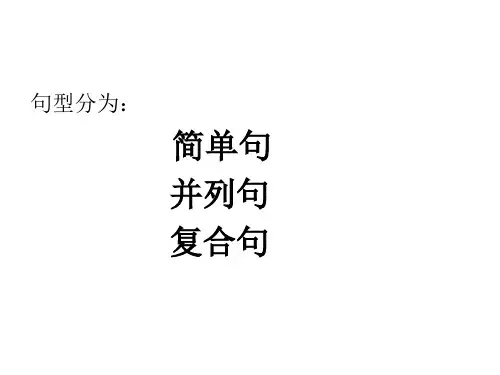
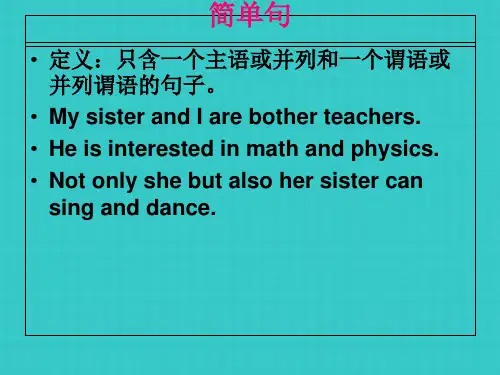
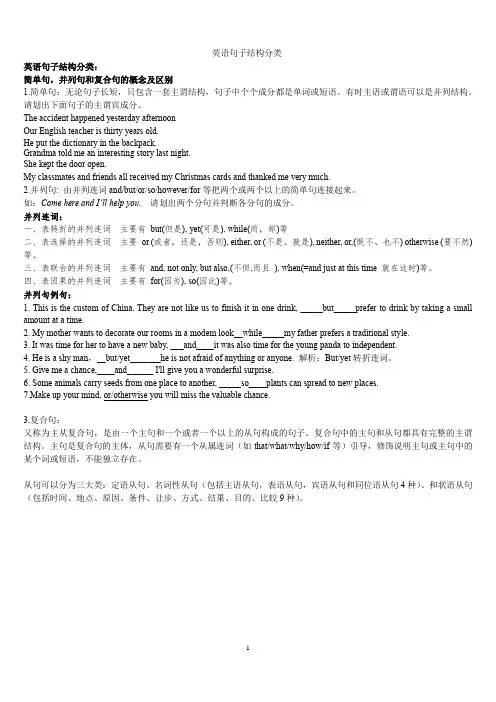
英语句子结构分类英语句子结构分类:简单句,并列句和复合句的概念及区别1.简单句:无论句子长短,只包含一套主谓结构,句子中个个成分都是单词或短语。
有时主语或谓语可以是并列结构。
请划出下面句子的主谓宾成分。
The accident happened yesterday afternoonOur English teacher is thirty years old.He put the dictionary in the backpack.Grandma told me an interesting story last night.She kept the door open.My classmates and friends all received my Christmas cards and thanked me very much.2.并列句: 由并列连词and/but/or/so/however/for等把两个或两个以上的简单句连接起来。
如:Come here and I’ll help you. 请划出两个分句并判断各分句的成分。
并列连词:一、表转折的并列连词主要有but(但是), yet(可是), while(而,却)等二、表选择的并列连词主要or (或者,还是,否则), either, or (不是、就是), neither, or,(既不、也不) otherwise (要不然)等。
三、表联合的并列连词主要有and, not only, but also,(不但,而且), when(=and just at this time 就在这时)等。
四、表因果的并列连词主要有for(因为), so(因此)等。
并列句例句:1. This is the custom of China. They are not like us to finish it in one drink, _____but_____prefer to drink by taking a small amount at a time.2. My mother wants to decorate our rooms in a modem look__while_____my father prefers a traditional style.3. It was time for her to have a new baby, ___and____it was also time for the young panda to independent.4. He is a shy man,__but/yet_______he is not afraid of anything or anyone. 解析:But/yet转折连词。
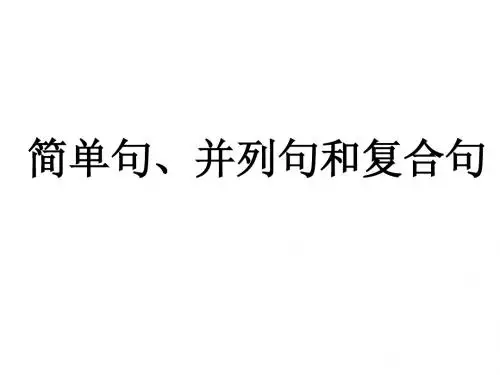

简单句、并列句、复合句根据语法形式,即句子的结构,英语的句子可分为简单句、并列句和复合句。
1简单句句型:主语+谓语只包含一个主谓结构,而句子的各个结构都只由单词或短语表示They are playing baseball in the garden.他们正在公园里打棒球。
Her brother and sister both are teachers.她的哥哥和姐姐都是老师。
2并列句句型:简单句+并列连词+简单句(常见的并列连词有and,but,or)并列句是由两个或两个以上的简单句连接而成。
并列句中的各简单句意义同等重要,相互之间没有从属关系,是平行并列的关系。
它们之间用连词连结。
Her father is a doctor and her mother is a teacher.I liked the story very much but Li Ming wasn''t interested in it.Hurry up,or you''ll be late.3 复合句句型:主句+连词+从句;或连词+从句+主句(包含一个主句、一个或一个以上的从句,或只包含一个从句,但有两个或两个以上的主句的句子叫复合句。
)复合句(The Complex Sentence):句子中有一个或一个以上的从句,叫做复合句。
复合句可分为:1).定语从句(The Attributive Clause);2).状语从句(The Adverbial Clause);3).名词性从句(The Noun Clause):一、定语从句•定语从句的定义定语从句在句子中作定语,用来修饰一个名词、名词词组或者代词。
•先行词和引导词被修饰的名词、名词词组或代词叫做先行词;在先行词和定语从句之间起连接作用的词叫做引导词。
引导词分为“关系代词”和“关系副词”。
•关系代词和关系副词关系代词有:who, whom, whose, that, which, as。
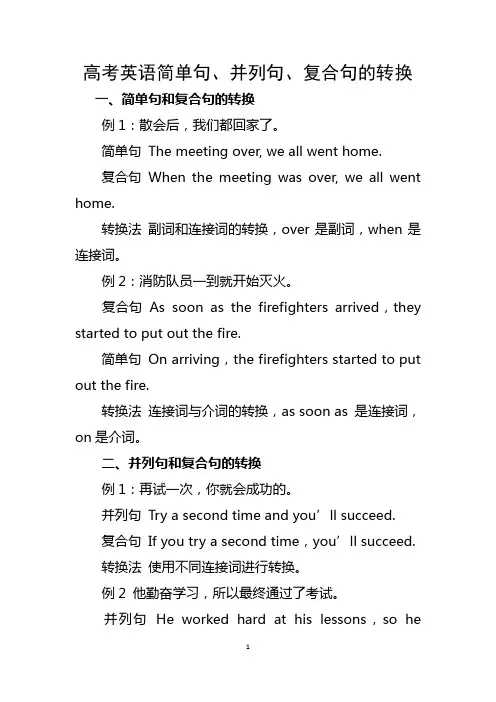
高考英语简单句、并列句、复合句的转换一、简单句和复合句的转换例1:散会后,我们都回家了。
简单句The meeting over, we all went home.复合句When the meeting was over, we all went home.转换法副词和连接词的转换,over是副词,when是连接词。
例2:消防队员一到就开始灭火。
复合句As soon as the firefighters arrived,they started to put out the fire.简单句On arriving,the firefighters started to put out the fire.转换法连接词与介词的转换,as soon as 是连接词,on是介词。
二、并列句和复合句的转换例1:再试一次,你就会成功的。
并列句Try a second time and you’ll succeed.复合句If you try a second time,you’ll succeed.转换法使用不同连接词进行转换。
例2 他勤奋学习,所以最终通过了考试。
并列句He worked hard at his lessons,so hepassed the exam eventually.复合句He passed the exam eventually because he worked hard at his lessons.转换法使用不同连接词进行转换。
三、复合句中从句的相互转换例1:这些工人是否能赚足够的钱还是个问题。
主从Whether the workers can earn enough money is still a question.表从The question is whether the workers can earn enough money.例2:我不知道他们住在哪里。
宾从I don’t know where they live.(及物动词know 之后)定从I don’t know the place where they live.(有先行词place)同从I have no idea where they live.(解释说明idea 的内容)例3:把书放到它原来的地方。

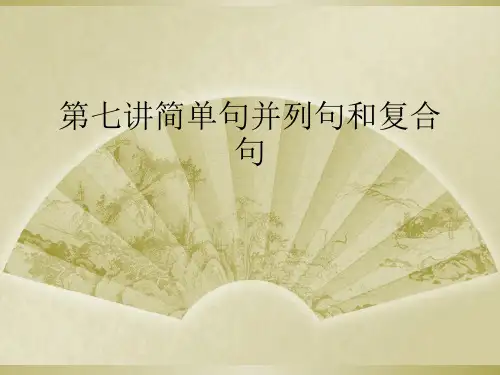
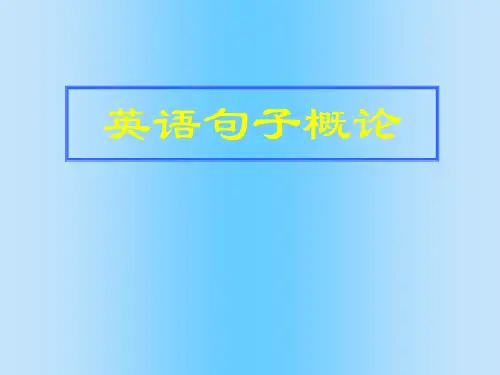
简单句、并列句、复合句
一.简单句:仅有一个主谓结构的句子叫简单句。
1.主语、谓语在人称与数上的一致性。
and连接两个并列主语时为复数,谓语动词也相应地使用复数形式,但:
(1)如果and连接的两个名词是不可数名词且前面都没有冠词,若两个词表示一个事物或一个概念,谓语动词要用单数;如果两个词表示的是两个事物或两个概念,谓语动词则要用复数。
(2)如果and连接的是两个可数单数名词,前一个有冠词,后一个没有冠词,意味着一个人或事物,谓语动词要用单数。
(3)当and连接的两个名词前都有each,every,many a,no等单数概念的限定词修饰时(第二个名词前的修饰词有时可以省略),谓语动词要用单数。
2.陈述句与疑问句的转换。
3.选择疑问句。
4.反意疑问句。
(1)陈述句+省略问句
(2)祈使句+附加疑问句
反意疑问句的回答
二.并列句由并列连词把两个或两个以上的互相关连而又互相独立的独句(即简单句)连在一起而构成的句子叫并列句。
其结构是:简单句+并列连词+简单句
常用的连词有and,but,or not only...but also,neither...nor,either...or
联合并列句常由并列词and, not only…but also…..等连接
如: Use your hand, and you’ll find a way.
转折并列句常由并列连词but, while, yet, whereas, nevertheless等连接
如:I would love to have gone to the party last night but I had to work extra hours to finish a report. 选择疑问句常由并列连词or, otherwise, either…or…,等连接
如:Either you leave this house or I’ll call the police
因果并列句由并列连词so, for, therefore 等连接.
如: it was late, so we went home.
在”祈使句+and/or+陈述句”结构中,当前后两部分间为承接关系时,用and;前后意思为相反关系时,用or.可将前面的祈使句转换成由if引导的条件状语从句,但必须将and 或or 去掉. 如: Hurry up, and we’ll be there in time.= If we hurry up, we’ll be there in time.
because和so; although, though和but 不能连用
三.复合句:有一个主句和若干个从句组成
1. What I want to explain is this.
2.We should never pretend to know what we don’t know.
3.That’s exactly what I am planning to do.
4.We expressed the hope that they would come and visit china again.
5.He asked me to stay where I was.
6. The comrade whom you spoke to is a model worker.。